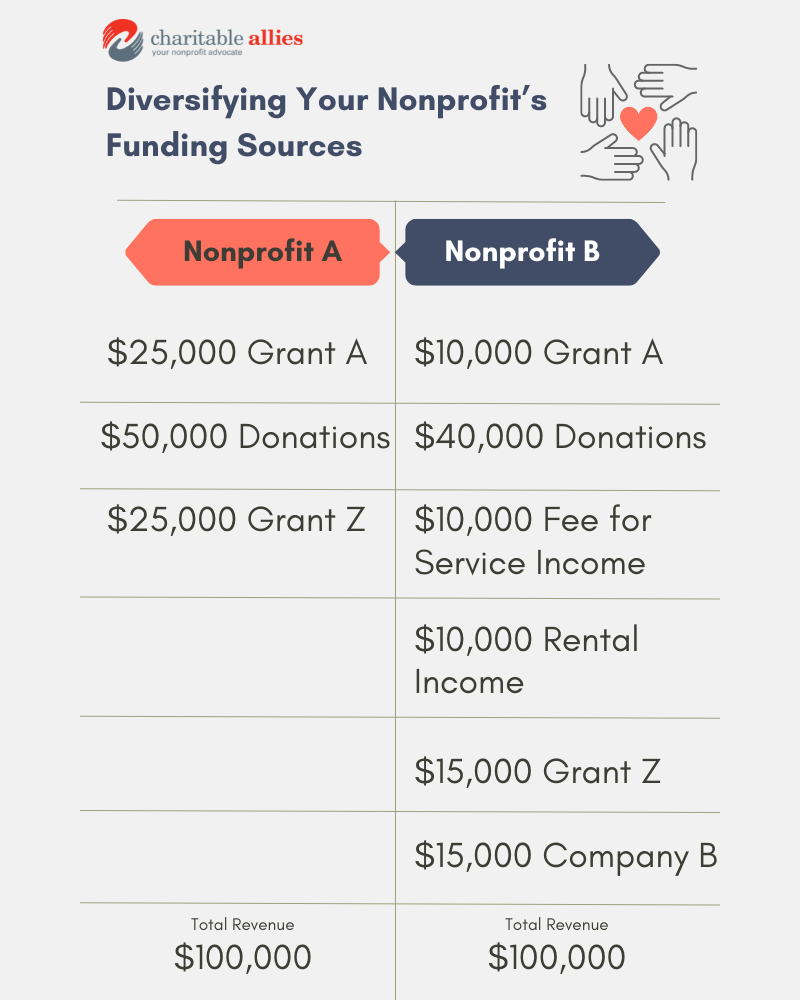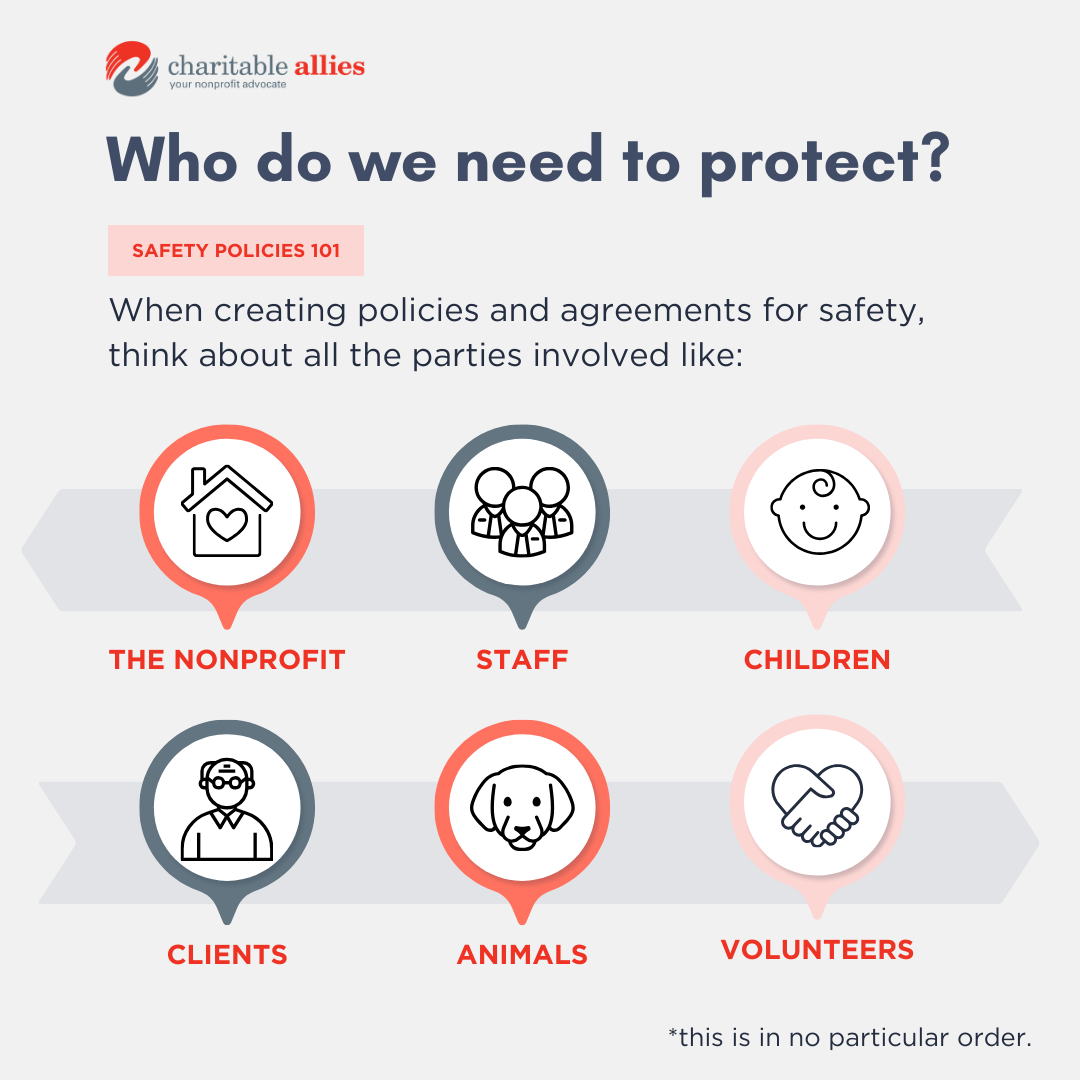Wondering what 2024 will bring for your nonprofit? Our friends at Charitable Allies have outlined three things you need to know in 2024 to ensure your nonprofit thrives.
1. Nonprofit Leader Tip #1: Having multiple sources of income for your nonprofit is more important than ever.
It’s no secret: many nonprofits have struggled to have stable sources of funding after the pandemic. One way to combat this is to diversify your funding strategy. Yes, you should be fundraising from individual donors, corporate sponsors, and applying for grants where applicable.
But is your nonprofit funded by more than just grants and fundraising? Take a look at other ways your nonprofit could bring in stable funding. This could include:
- Selling goods (like branded t-shirts or tickets to a performance)
- Charging for your charitable services or Program Service Revenue (like a low-cost animal clinic charging low rates for medicine)
- Renting out your building or other assets (like vehicles)
Having a mix of funding sources can create a healthier, more sustainable organization long-term. Here’s an example:
In the example above, if Nonprofit A loses only one of their grants, they’ve now lost 25% of their revenue! For many nonprofits, losing 25% of revenue is enough to close down a program or lay off staff. Whereas, if Nonprofit B loses funding in one area, they have multiple other sources of funding they can attempt to increase to make up for the loss. It’s best to work towards having a variety of funding sources, provided your organization can still pass the public support test.
Just keep in mind that when it comes to bringing in funding through methods other than donations or grants, there are rules that apply, so check with a qualified attorney before moving forward. You can also attend our free webinar about going beyond fundraising to bring in funding!
2. Nonprofit Leader Tip #2: If you’re working with a high-risk or vulnerable population, make sure you have the proper policies in place.
For nonprofits working with people or animals regularly, make sure you have the right documents and policies in place. Ultimately, these documents are aimed at protecting the animals or people you serve, while also protecting the nonprofit and the staff from potential lawsuits. The old adage rings true: an ounce of prevention is worth a pound of cure. It’s much less expensive to create the right policies and agreements ahead of time, rather than deal with the aftermath of a crisis.
First, look through your safety policies. Whether your program works with youth, the elderly, or those with developmental delays, having the right safety policies in place is critical. Your policy should outline things like:
- Any requirements for staff or volunteers who directly serve with your clients. Do you require a background check and/or character references? Are minors allowed to volunteer? If so, are they required to be accompanied by an adult?
- Online safety policies. Often overlooked, online safety policies are becoming more and more important. Are staff or volunteers allowed to follow your clients on social media? Are staff or volunteers allowed to direct message or text clients? Are volunteers or staff allowed to text or direct message people regarding private client matters?
- Abuse or inappropriate behavior prevention. This can include things like preventing one-on-one interactions in private (especially with minors) or how to report suspected inappropriate behavior.
- Violent incident protocols. Whether it’s an animal who is injured exhibiting aggressive behavior or a child who is lashing out at your staff, what procedure should be followed in the event of a violent incident? What steps should be taken in those situations to report and document the situation appropriately? How would any potential medical care be handled?
This is by no means an exhaustive list, but can get you started on the right track. Many organizations that depend on volunteers also choose to have a volunteer agreement that volunteers are required to review and sign. This ensures expectations are clear and holds volunteers to a high standard of safety and care.
Truly, the type of safety measures you need depends on the type of programs you operate. Here are a few examples:
- If you work with animals, adoption and/or fostering policies and agreements can help ensure a great standard of care for your furry friends.
- If you transport any clients, like the elderly or children, having a policy surrounding transportation can help ensure safety for everyone.
- If your church has a children’s program or a school, having a policy surrounding child abuse prevention procedures and potential abuse reporting is a must.
- If you work internationally, having an OFAC Compliance policy is important.
- If you have multiple locations of your nonprofit or church, ensuring certain standards across multiple locations can ensure your program is carried out consistently despite geographic differences.
There’s no getting around it: having the right agreements and policies in place can ensure safety of volunteers, staff and clients, as well as protect the nonprofit from additional liability. The right documents (and enforcing them!) can protect everyone involved and save your nonprofit thousands down the road.
3. Nonprofit leader tip #3: If you’re looking to thrive amidst financial challenges, cutting costs alone is not the solution.
When inflation has driven the cost of everything up, and your nonprofit isn’t bringing in enough funding to make up for the difference, what can be done? I see many nonprofit leaders focus on slashing every potential cost– even if their program was already lean. But slashing costs alone isn’t the answer.
We can take a lesson from our for-profit friends to find what works. A study of 4700 companies in the Harvard Business Review looked at how they fared in recessions and how well they recovered once the financial crisis was over. The organizations that both survived the recession and went on to thrive afterward were masters of balance. They both cut costs where they could and invested in growth. It takes both common-sense caution and a willingness to innovate to come out ahead when times are tough. So what could that look like in a nonprofit context?
Here’s an example. Your team is already overwhelmed with the amount of work they have to do, and they especially hate some of the administrative tasks like scanning documents, cleaning up around the office and ordering office supplies. Rather than push your team to “do more with less” or hire an administrative staff member you can’t afford, train a few volunteers to handle the administrative tasks. This will keep your staff happier, preventing costly turnover and allows you to not spend precious resources on those tasks.
Or let’s say you have three programs you run for local kids. Two of those programs bring in enough program service revenue to cover their own costs (if you need help determining how much to price your services at, please join us for our upcoming webinar!). But one of the programs isn’t breaking even. The program is notoriously difficult to staff, and while there is a need in the community for it, this program always seems to be in crisis. Make the difficult choice to shut this program line down. The money you save from shutting down that program can be diverted into the other two programs, making those two thrive. It can be heartbreaking to make these choices, but ultimately, making the tough call can actually improve your ability to serve your cause. When every penny counts, make sure your resources are going to where they can do the most good.
Conclusion
If the past few years have taught us anything, it’s that we can’t predict the future. But we can do our best to prepare for anything. If you’re interested in hearing more from the legal team at Charitable Allies, check out our free webinar.
Learn more tips for legal funding at Charitable Allies upcoming FREE webinar - Register Today!



